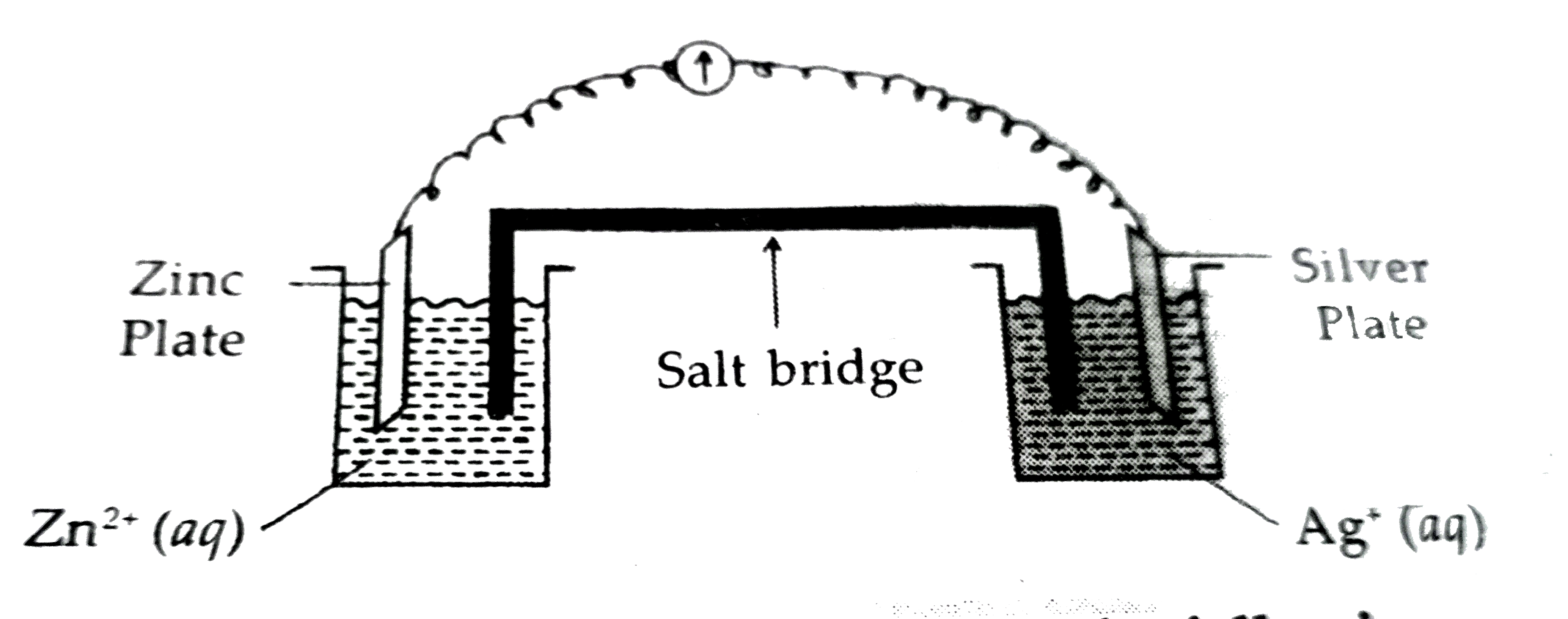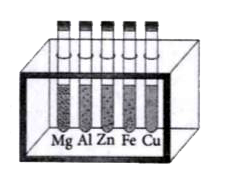The position of some metals in the electrochemical series in decreasing electropositive character is given as Mg>Al>Zn>Cu>Ag. What will happen if a copper spoon is used to stirr a solution of aluminimum nitrate ?
The spoon will get coated with Al
An alloy of Cu and Al is formed
The solution becomes blue
There is no reaction
The correct Answer is:D
The metal placed below in electrochemical series does not react with that metal salt solution with which metal is placed above in series .
Topper's Solved these Questions
- BOOK - A2ZCHAPTER - ELECTROCHEMISTRYEXERCISE - Assertion-Reasoning Questions10videos
ELECTROCHEMISTRY
- BOOK - A2ZCHAPTER - COORDINATION COMPOUNDSEXERCISE - Section D - Chapter End Test30videos
COORDINATION COMPOUNDS
- BOOK - A2ZCHAPTER - GENERAL PRINCIPLES AND PROCESS OF ISOLATION OF METALSEXERCISE - Section D - Chapter End Test30videos
GENERAL PRINCIPLES AND PROCESS OF ISOLATION OF METALS
Similar Questions
(a) What is the activity series of metals ? Arrange the metals Zn, Mg, Al, Cu and Fe in a decreasing order of reactivity.
(b) What would you observe when you put
(i) some zinc pieces into blue copper sulphate solution ?
(ii) some copper pieces into green ferrous sulphate solution ?
(c ) Name a metal which combines with hydrogen gas. Name the compound formed.View Solution(a) When a bright silver object is placed in the solution of gold chloride, it acquires a golden tings but nothing happens when it is placed in solution of copper chloride. Explain this behaviour of silver.
[Given : E∘Cu2+/Cu=+0.34V,E∘Ag+/Ag=+0.80V,E∘Au3+/Au=+1.40V]
(b)
Consider the figure given above and answer the following questions :
(i) What is the direction of flow of electrons?
(ii) Which is anode and which is cathode?
(iii) What will happen if the salt bridge is removed ?
(iv) How will concentration of Zn2+ and Ag+ ions be affected when the cell functions ?
(v) How will concentration of these ions be affected when the cell becomes dead ?View Solution
Knowledge Check
- Question 1 - Select One
The position of some metals in the electrochemical series in dectreasing electropositeve character is given as Mg>Al>Zn>Cu>Ag. What will happen if a copper spoon is used to stir a solution of aluminimum nitrate ?
AThe spoon will get coated with aluminiumBAn alloy of aluminium and copper nitrateCThe solution becomes blueDThere is no reaction - Question 2 - Select One
The position of some metals in the electrochemical series in dectreasing electropositeve character is given as Mg<Al>Zn>Cu>Ag. What will happen if a copper spoon is used to stir a solution of aluminimum nitrate ?
AThe spoon will get coated with aluminiumBAn alloy of aluminium and copper nitrateCThe solution becomes blueDThere is no reaction - Question 3 - Select One
The position of some metals in the electrochemical series in decreasing electropositive character is given below:
Mg > Al> Zn > Cu > Ag
What will happen if a copper spoon is used to stir a solution of aluminium nitrate?AThe spoon will get coated with aluminiumBAn alloy of aluminium and copper nitrateCThe solution becomes blueDThere is no reaction
Read the following passage and then answer questions on the basis of your under standing of the passage and the related studied concepts. Passage: For an LCR series circuit driven with an alternating voltage of amplitude Vmand angular frequency oo, the current amplitude is given as
Im=Vmz=Vm√R2+(XL−XC)2=Vm√R2+(Iω−1cω)2
If ω is varied then for a particular frequency ω0,XC=XL and then Z = R and hence, Im=VmR is maximum. This frequency is called the resonant frequency. The resonant frequency ω0=1√LC = Resonance of a LCR series a.c. circuit is said to be sharping current amplitude Im falls rapidly on increasing/decreasing the angular frequency from its resonant value 0. Mathematically, sharpness of resonance is measured by the quality factor of the circuit, which is given as:
Q=ωLR=1R√LC
(c) What is the nature of reactance in the circuit when (i) ω<ω0 and (ii) ω>ω0 ?View SolutionThe position of some metals in the electropositive decreasing electropositive character is given as Zn>Cu>Ag. What will happen if a copper is to stir a solution of aluminium nitrate.
View SolutionA copper coin is kept immersed in a solution of silver nitrate for some time. What will happen to the coin and the colour of the solution?
View SolutionClean small pieces of magnesium, zinc, aluminium, iron and copper by rubbing them with a piece of sand paper. Take them in separate test tubes. Add about 10 mL of dilute hydrochloric acid to each of them.

Consider the following statements.
(i) The rate of evolution of hydrogen gas bubbles is not same in all the test tubes.
(ii) The rate of formation of bubbles is the fastest in the case of magnesium.
(iii) The reactivity decreases in the order:
Mg>Zn>Al>Fe>Cu.
(iv) In the case of copper, no bubbles are seen and the temperature also remains unchanged. This shows that copper does not react with dilute HCl.
Identify the correct option.View SolutionAn organic reaction occurs through making and breaking of bonds. The breaking of bonds may occur either homolytically leading to the formation of radicals or heterolytically generating positively and negatively charged species. The neutral species (free radicals, carbenes, nitrenes, etc.) and positively charged species being electron deifcient are collectively called electrophiles while neutral and negatively charged species which are electron rich are called nucleophiles. An organic reaction usually involves the attack of a reagent (radicals, positively and negatively charged species) on the substrate molecule). The substrate molecule, although as a whole electrically neutral, has centres of low and high electron density due to displacement of bonding electrons. These electrons displacements occur through inductive, electromeric occur through inductive, electromeric, resonance and hyperconjugation effects. Whereas inductive effects involve displacement transfer of n-and π-electrons along a conjugated system. Hypercongation effects, on the other hand, involve σ−π-conjugation. Both inductive and hyperconjugation effects can be used to explain the stability of carbocations and free radicals which follow the stability order: 3∘>2∘>1∘. The stability of carbanions, however, follows opposite order.
The stability of a molecule can be judged on the basis of contribution of its resonance structures. Resonance structures have same position of nuclei and have same number of unpaired electrons. Among resonance structures, the one which has greater number of covalent bonds, has less separation of opposite Charges, a negative charge on more electronegative and a positive charge on a more electropostive atom are more stable than others.
What is the decreasing order of stability of the ions ?
I. CH3−+CH−CH3 II. CH3+CH−OCH3
III. CH3−+CH−COCH3View Solution

